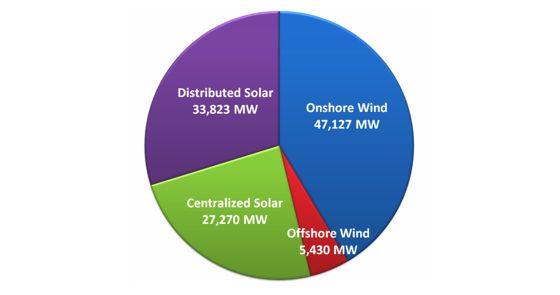PJM Interconnection, the nation’s largest power transmission grid organization, announced recently that wind and solar power could generate about 30 percent of PJM’s total electricity for its territory covering the Mid-Atlantic region and part of the Midwest by 2026 without “any significant issues.”
That’s engineer-speak for “no big deal.” Even better, we would see more clean power at less cost and with far less pollution than our current mix of coal and natural gas power plants.
PJM’s new renewables integration report, prepared by General Electric, is required reading for anyone who questions the ability of the electric grid to handle large amounts of wind, solar and other renewable energy. GE estimates that about 113,000 megawatts of installed wind and solar power resources (including distributed/generation), could produce about 30 percent of the region’s total energy. That’s enough energy to power 23.5 million homes annually.
Here’s the breakdown of the resource mix in one of the scenarios studied in the report:

Significant benefits from more clean energy
The report estimates that 30 percent penetration levels of wind and solar power in PJM territory would bring the following benefits:
- 40 percent less carbon pollution than “business as usual”
- Lower average energy prices across PJM’s footprint, because wind and solar would avoid $15.6 billion in coal and natural gas fuel costs
- Very little additional power (only 1500 megawatts) needed to support the minute-to-minute variability of the renewable power
- No additional operating (known as “spinning”) reserves needed for backup power
- 44 percent less gas-fired generation and 21 percent less coal-fired generation, which also reduces the amount of carbon pollution emitted into the atmosphere
The benefits derive primarily from several facts: 1) solar and wind power have zero fuel cost, which makes up most of the price of energy; 2) these resources are now commercially available and competitive with other power; 3) they produce zero carbon and other pollution; and 4) PJM’s large size across fourteen states significantly reduces the magnitude of weather-caused variations in power output that can occur during the day and night.
What grid changes may be necessary?
Getting all of this additional clean energy will require more transmission lines, which PJM’s study estimated would cost $8 billion. That is still far less the $15.6 billion in energy savings. But even that’s probably an exaggeration, since PJM’s study looked only at renewable energy expansion inside PJM. It didn’t consider, for example, the savings from importing some of the wind power from the Dakotas, Minnesota, Iowa, or other parts of the wind-rich Midwest and Great Plains. When you factor in those possibilities, the total transmission cost of achieving the 30 percent renewables integration could be lower than PJM’s predictions.
The study also recommends several relatively modest steps that PJM can take to successfully integrate these resources into the system. They include changes in the way PJM operates its energy markets and dispatches power on a minute-to-minute basis, taking a more detailed look at reserve requirements, and potentially improving the “flexibility” of baseload plants to better integrate them with renewable energy resources.
Looking to the future and taking next steps
This study gives consumers, states, utilities, and others some things to think about in several areas.
First, it’s clear that the grid can handle high levels of renewable power without compromising reliability. Of course, we already know this because the Midwest and Texas grids have seen wind energy constitute a significant portion of the power on the grid at a given time. The PJM study affirms that the grid can handle much higher power levels. It also provides a stepping stone to evaluating the impacts and savings of even more renewable power on the grid, which will be a top priority for states looking to satisfy the U.S. Environmental Protection Agency’s upcoming carbon pollution rules for existing power plants.
Second, as conventional power sources come to constitute less of the total energy production mix, power markets will need to evolve to encourage the development of complementary conventional resources. This is a critical point. PJM’s study shows that existing coal and gas resources are going to suffer revenue losses; indeed, PJM even suggested that it might be necessary to consider raising energy prices to compensate for the lost revenue. No, no, no.
A better approach is to look into redesigning PJM’s existing long-term power supply market (called a “forward capacity market”) so that it, in combination with reasonable state power preferences, assures the right supply of conventional power sources are available to support renewable power.
Third, PJM’s study was done in a relative vacuum; it didn’t consider how several grid regions, working together, could manage significantly more clean power. PJM and the other grid operators across the country need to work in a more cooperative manner to conduct the studies and other work necessary to show states across the country that power-sharing saves even more money than for each region to plan for its own resources. FERC has encouraged this cooperation by issuing interregional coordination requirements in its landmark Order 1000 (more about that here), but the regions can do more -- and they don’t need to wait for further instructions from Washington.
***
John Moore is a senior attorney with the Natural Resources Defense Council. This piece was originally published on NRDC's Switchboard blog and was reprinted with permission.



